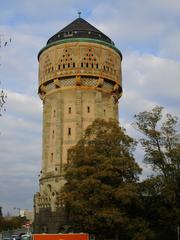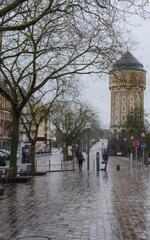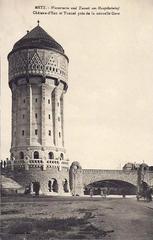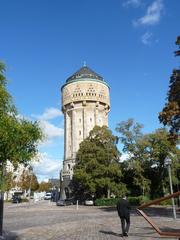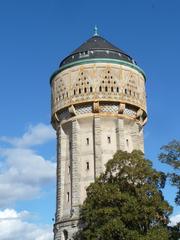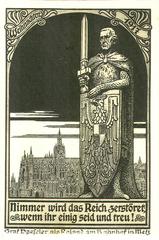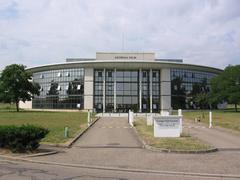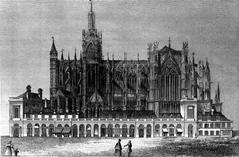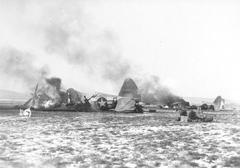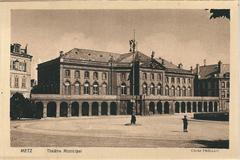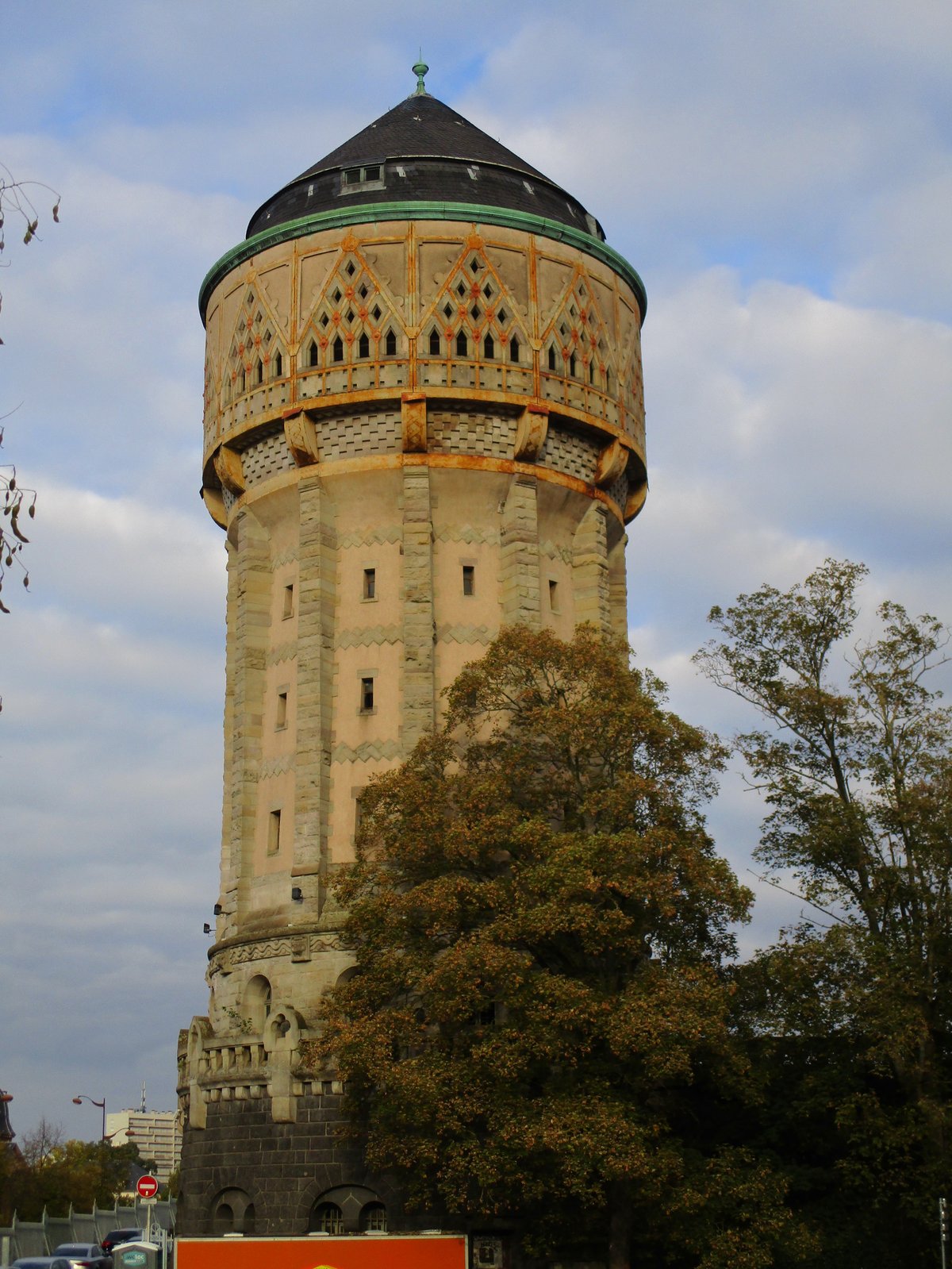
Metz Station Water Tower: Visiting Hours, Tickets, and Historical Significance in Metz, France
Date: 14/06/2025
Introduction
Rising above Metz’s Imperial Quarter, the Metz Station Water Tower is both an architectural marvel and a symbol of the city’s dynamic Franco-German heritage. Built between 1905 and 1911 under German annexation, this neo-Romanesque monument originally served as a vital water supply for steam locomotives. Today, its imposing silhouette and historical resonance invite visitors to explore the layered story of Metz’s urban transformation, military strategy, and cultural identity.
This comprehensive guide offers all the essential information for visiting the Metz Station Water Tower: opening hours, ticketing, accessibility, guided tours, and nearby attractions. Whether you are a history buff, architecture enthusiast, or a traveler eager for authentic experiences, discover how to make the most of your visit to this remarkable landmark.
Table of Contents
- Introduction
- Historical Background and Urban Context
- Architectural Features and Engineering
- Visiting the Metz Station Water Tower
- Nearby Attractions
- Practical Tips for Visitors
- Cultural Resonance and Heritage Status
- FAQ: Metz Station Water Tower Visiting Information
- Conclusion and Call to Action
- References
Historical Background and Urban Context
Imperial Ambitions and Urban Transformation
The Metz Station Water Tower was constructed during the German annexation of Metz (1871–1918), a period marked by ambitious urban planning and architectural innovation. As part of the Imperial Quarter’s development, the water tower and adjacent Gare de Metz-Ville railway station embodied the German Empire’s desire to assert its presence and modernize the city’s infrastructure (French Moments; Wikipedia: Imperial Quarter of Metz).
Strategic and Military Significance
Metz’s strategic location near the French-German border made it a military stronghold. The water tower, with its 40-meter height and 300 cubic meter capacity, was designed to support rapid mobilization by supplying steam engines crucial for both civilian travel and military logistics (Navaway). Its robust construction reflects the era’s focus on both function and fortification (French Moments).
Neo-Romanesque Architecture and Urban Planning
Designed by Conrad Wahn, the water tower is a quintessential example of neo-Romanesque architecture, characterized by rounded arches, thick walls, and fortress-like features. The use of pink and grey sandstone and basalt from the Rhineland, rather than local yellow limestone, was a deliberate choice to underline Germanic identity. The tower anchors the Imperial Quarter’s grand boulevards and eclectic buildings, symbolizing Metz’s emergence as a cosmopolitan city (French Moments).
Architectural Features and Engineering
The tower’s distinctive cylindrical structure, massive stonework, corbelled cornice, and slate-covered conical roof create a medieval-inspired presence on the Metz skyline. Its design harmonizes with the surrounding railway station and public buildings, reinforcing the area’s unified architectural vision.
Inside, the tower originally housed a gravity-fed water reservoir, serving steam locomotives and showcasing early 20th-century engineering. Though no longer operational, the structure remains an emblem of industrial heritage and technological progress (Tourisme Metz PDF).
Visiting the Metz Station Water Tower
Opening Hours & Tickets
- Opening Hours: The Metz Station Water Tower is generally open to visitors from Tuesday to Sunday, 10:00 AM to 6:00 PM. Hours may vary seasonally or during special events, so check the Metz Tourist Office website for the latest updates.
- Tickets: Admission is €5 for adults, with discounts for students, seniors, and groups. Children under 12 enter free. Tickets can be purchased online or at the entrance.
Accessibility
The ground floor and surrounding areas are wheelchair accessible. Historic constraints may limit access to upper levels, but assistance can be arranged upon request. Facilities such as restrooms and cafés are available nearby in the railway station.
Guided Tours and Visitor Experience
Guided tours are available on weekends and public holidays, offering in-depth insights into the tower’s history, architecture, and role within Metz’s urban development. Tours can be booked via the Metz Tourist Office. Audio guides and multilingual brochures are provided to enhance the visitor experience.
Special Events and Photographic Spots
The tower is occasionally illuminated during local festivals, creating stunning photographic opportunities, particularly at sunset or night. The best views are from the station forecourt, Avenue Foch, and Place Saint-Thiébault.
Nearby Attractions
Enhance your visit by exploring these nearby sites:
- Gare de Metz-Ville: The monumental railway station, known as the “Palace Station,” with imperial apartments and grand interiors.
- Imperial Quarter: Discover the area’s eclectic architecture, wide boulevards, and public gardens.
- Metz Cathedral (Saint-Étienne): A Gothic masterpiece with the largest expanse of stained glass in France.
- Centre Pompidou-Metz: A striking modern art museum just a short walk away.
- Temple Neuf: A Romanesque Revival church beautifully set on the Moselle River.
- Porte des Allemands: A medieval fortification offering scenic walks and historic ambiance.
- Eglise Saint-Pierre-aux-Nonnains: Among Europe’s oldest churches, now a venue for exhibitions and concerts.
- Marché Couvert: Metz’s covered market, open Tuesday to Saturday, featuring regional specialties.
Practical Tips for Visitors
- Best Time to Visit: Early morning or late afternoon for optimal lighting and fewer crowds. Spring and autumn provide pleasant weather.
- Combine Visits: Pair your tower visit with a stroll through the Imperial Quarter or a trip to the Centre Pompidou-Metz.
- Sustainable Travel: Metz is walkable and bike-friendly; consider public transport or cycling to reduce your environmental impact.
- Photography: For dramatic shots, visit at dusk or during festival illuminations.
Cultural Resonance and Heritage Status
The water tower, once a symbol of German imperial power, now represents Metz’s resilience and evolving identity. The Imperial Quarter, including the tower, is recognized as a Historic Monument and is under consideration for UNESCO World Heritage status, affirming its importance in the city’s architectural and cultural legacy (French Moments; travelfrancebucketlist.com).
Frequently Asked Questions (FAQ)
Q: What are the visiting hours for the Metz Station Water Tower?
A: Open Tuesday to Sunday, 10:00 AM to 6:00 PM, with seasonal variations.
Q: Are tickets required, and where can I buy them?
A: Yes, tickets cost €5 for adults and can be purchased online or onsite.
Q: Is the water tower accessible for visitors with disabilities?
A: The ground floor is accessible; upper levels may have limited access. Assistance is available.
Q: Are guided tours available?
A: Yes, on weekends and public holidays. Book in advance via the Metz Tourist Office.
Q: Can I take photos inside the water tower?
A: Photography is generally allowed; some exhibitions may have restrictions.
Q: What are the best nearby attractions to visit?
A: Gare de Metz-Ville, Imperial Quarter, Centre Pompidou-Metz, Metz Cathedral, and more.
Conclusion and Call to Action
The Metz Station Water Tower is more than a functional relic—it stands as a testament to the city’s layered history, architectural grandeur, and spirit of Franco-German reconciliation. Whether you’re captivated by its neo-Romanesque details, intrigued by its military past, or drawn to the vibrant Imperial Quarter, the tower offers a rich and rewarding visitor experience.
Plan your visit today:
- Check updated hours and purchase tickets via the Metz Tourist Office.
- Download the Audiala app for audio guides, maps, and exclusive content.
- Explore nearby attractions to immerse yourself in Metz’s unique blend of history and culture.
- Follow Metz tourism on social media for events and updates.
Let the Metz Station Water Tower be your gateway to discovering the heart and heritage of Metz.
